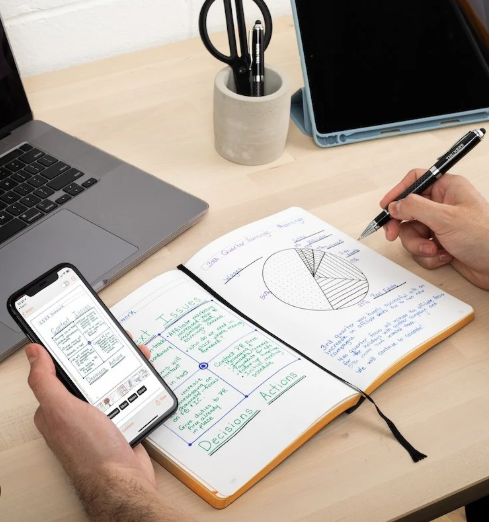Effective note organization is essential for academic success. Well-structured notes help students review material efficiently, retain more information, and stay focused on their learning goals. Thanks to digital tools, students can now organize their study notes in creative, personalized, and highly functional ways. Whether you’re in high school, college, or engaged in lifelong learning, the right tools can turn scattered thoughts into a cohesive and accessible knowledge base. Below are some of the best tools available for organizing study notes across subjects and learning styles:
- Notion (notion.so) – A powerful all-in-one workspace that allows students to take notes, build study dashboards, create to-do lists, and organize subject folders. Notion supports embedded links, databases, checkboxes, tables, timelines, and multimedia. Students can design a personalized academic hub with class notes, reading logs, assignment trackers, and revision calendars. Notion also has a growing template gallery to help beginners get started.
- Evernote (evernote.com) – Known for its clean interface and strong tagging system, Evernote lets students capture class notes, web clippings, voice memos, and checklists. Notes can be organized by notebooks, tags, and reminders. It includes a web clipper for saving articles directly from the browser and OCR capabilities for searching handwritten or scanned content. Premium features offer offline access and more storage, but the free version is robust for most students.
- Microsoft OneNote (onenote.com) – Mimics the layout of a physical notebook with tabbed sections and pages. It’s highly flexible, supporting typed notes, handwriting, inserted images, and audio recordings. OneNote syncs across devices and integrates seamlessly with Microsoft Word, PowerPoint, and Outlook. It’s a favorite for STEM students because of its built-in math equation support and drawing tools.
- Google Keep (keep.google.com) – A lightweight tool for quick notes, checklists, and voice reminders. Notes can be color-coded, pinned, and tagged for easy retrieval. Google Keep is ideal for jotting down quick ideas and integrating them into Google Docs or Google Calendar. Students who already use Google Workspace will appreciate how seamlessly Keep fits into their workflow.
- Obsidian (obsidian.md) – A markdown-based note-taking app designed for building a network of linked notes. Ideal for students who prefer non-linear learning, Obsidian’s backlink and graph view features help connect concepts across disciplines. It’s especially useful for research projects, writing, and knowledge management over the long term. Obsidian is fully offline, with plugin support for customization.
- GoodNotes / Notability (iOS/iPad) – These apps are ideal for students who prefer handwritten notes using a stylus or Apple Pencil. Both support PDF annotation, organized notebooks, and multimedia integration. GoodNotes offers excellent handwriting recognition and searchability, while Notability includes audio recording that syncs with written notes, which is great for reviewing lectures.
- Trello (trello.com) – Originally designed as a project management tool, Trello’s visual board system can be adapted for note organization. Students can use boards for each subject, with lists for topics and cards for specific notes, resources, and deadlines. Trello’s checklists, due dates, attachments, and labels make it useful for organizing study plans and collaborative study groups.
- Zoho Notebook (zoho.com/notebook) – A colorful and user-friendly alternative for organizing notes into different card styles. It supports text, audio, sketch, photo, and checklist cards. Each subject can be stored in its own notebook with visually engaging covers. Students can sync notes across devices, and the app is free with no ads.
- Coda (coda.io) – Combines the functionality of notes, spreadsheets, and databases in one platform. Students can build interactive study plans, progress trackers, revision tables, and even digital flashcards. It’s suitable for highly organized learners who enjoy automation and structured planning.
- Scrivener (literatureandlatte.com) – Best for long-form academic projects, writing assignments, or research-heavy subjects. Scrivener’s binder system allows students to break notes into sections, rearrange them, and keep outlines, drafts, and references all in one place. It’s particularly popular with graduate students and writers working on theses or dissertations.
- Simplenote (simplenote.com) – A clean, distraction-free note app with markdown support. Ideal for students who want a fast, lightweight solution for plain text notes, to-do lists, and code snippets. Simplenote syncs across devices and includes version history and tagging features.
- Roam Research (roamresearch.com) – Designed for connected thinking, Roam lets students build a “second brain” by linking notes contextually. Its bullet-point and daily note structure is great for students who take frequent notes and want to build relationships between concepts. While it’s a paid platform, it’s loved by knowledge workers and researchers.
Tips for Organizing Study Notes:
- Use consistent headings, bullet points, and formatting to improve readability.
- Tag notes with course names, units, or key themes for faster searching.
- Link related notes to connect interdisciplinary concepts or previous topics.
- Include visuals like diagrams, graphs, and charts for better retention.
- Summarize each lecture or reading session with a key takeaways section.
- Color-code topics or subjects to enhance focus and memory recall.
- Review and revise notes weekly to identify gaps and reinforce learning.
How to Choose the Right Tool:
- If you prefer handwriting, try GoodNotes or Notability.
- If you value deep linking and connected notes, use Obsidian or Roam.
- For collaborative planning and task tracking, Trello and Coda are ideal.
- If you want cloud-based integration and ease of use, go with Google Keep or OneNote.
In summary, digital tools can help transform study notes into an organized, searchable, and personalized resource. By choosing a system that fits your study habits and academic goals, you can make note-taking a powerful tool for success in school and beyond. Whether you’re building a study schedule, preparing for exams, or organizing lecture notes, these platforms provide the flexibility and structure needed to excel in any learning environment.














